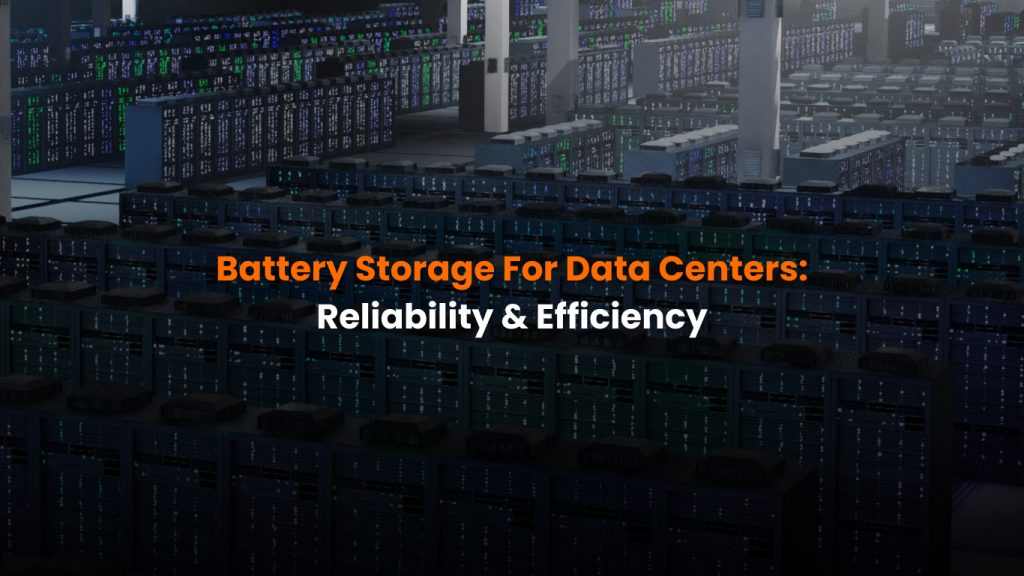Introduction
Modern data centers power the digital world – from streaming video to cloud computing – and they require constant, uninterruptible power. Even a momentary outage can result in lost data, service downtime, and major financial losses. Traditionally, data centers have relied on banks of diesel generators and lead-acid batteries for backup power. But today a cleaner, smarter solution is on the rise: battery storage. Advanced battery energy storage systems (BESS) are providing a strategic advantage for data centers, balancing the need for rock-solid reliability with cost savings and sustainability goals. In this blog, we explore how battery storage is transforming data center energy management – replacing diesel gensets, improving efficiency, and even supporting the broader electric grid.
The Power Demands of Data Centers
Data centers are often called the factories of the digital age. Racks of servers consume enormous amounts of electricity to compute and cool information. Globally, data centers already use about 2-3% of all electricity, and this share is growing. In the U.S., data center power use was roughly 130 TWh in 2022 (about 2.5% of national demand) and is projected to triple to 390 TWh by 2030, equivalent to the power used by ~40 million homes. This surging demand comes from our insatiable appetite for cloud services and emerging technologies like artificial intelligence, which require energy-intensive computing. For the companies running data centers, the twin priorities are power reliability (keeping servers online 24/7) and cost control (electricity is a major operating expense).
Historically, reliability was ensured by uninterruptible power supply (UPS) systems that include batteries (to handle short gaps) and diesel generators (to kick in during extended outages). Diesel generators, while effective at providing emergency power, come with downsides: they are polluting, require regular maintenance and fuel storage, and often sit idle most of the time (essentially expensive insurance). They also cannot respond to everyday energy management needs – they are used only during outages or periodic testing.
Enter modern battery storage solutions. With the dramatic improvements in lithium-ion battery technology, large-scale battery systems have become viable for data center backup and energy optimization. Lithium-ion batteries offer fast response, high energy density, and dropping costs. Tech giants and colocation providers are now experimenting with or deploying big battery banks on-site. These battery systems can fulfill the UPS role (bridging the gap until backup generation or grid power is restored) and do much more, as we’ll see below.
Replacing Diesel Generators with Battery Backup
A groundbreaking shift underway is the replacement of diesel backup generators with battery storage at data centers. For instance, Google announced in 2020 that it would install the first-ever battery-based backup system at a hyperscale data center, aiming to eliminate diesel generators over time. In one pilot at Google’s St. Ghislain facility in Belgium, a 2.75 MW/5.5 MWh battery system was retrofitted to provide backup power in lieu of diesel units. This BESS not only provides instant emergency power to the data center, but also can feed energy back to support the local grid when not needed for backups.
This trend is driven by multiple benefits:
- Instant Response: Batteries react in milliseconds to an outage, seamlessly keeping servers online. There’s no startup lag as with diesel gensets. This means even a brief power flicker triggers the battery to hold up the load without any interruption to critical equipment. By contrast, a generator might take several seconds to start and sync, during which time batteries (or a flywheel) must cover – a battery-only system simplifies this.
- Reduced Emissions and Maintenance: Unlike diesel engines, batteries produce no on-site emissions and require far less maintenance. Data center operators can avoid weekly generator testing runs (which burn fuel and emit exhaust) and the logistical headaches of fuel delivery and storage. Google noted that moving from traditional lead-acid batteries + diesel to lithium-ion batteries meant deploying one-quarter the number of batteries and greatly reducing waste and maintenance needs. Over a battery’s life, the total cost can be lower when factoring fuel, engine upkeep, and environmental compliance for generators.
- Grid Services & Efficiency: Perhaps most interestingly, large batteries can do useful work even when the grid is healthy – something diesel generators cannot. Most of the time, backup generators sit idle. Batteries, on the other hand, can be charged or discharged daily to help manage the data center’s power consumption. For example, a data center could charge its batteries at night when grid electricity is cheap or when its onsite solar energy array (if it has one) produces excess power, then discharge the batteries during afternoon peak hours to reduce drawing expensive grid power. This practice, known as peak shaving, cuts operating costs by lowering demand charges and energy bills. Additionally, data centers with batteries are starting to partner with utilities to provide grid stability services: injecting power to the grid or absorbing excess as needed. In Belgium, Google’s battery system is set to support the national grid operator (Elia) by providing fast frequency response and other ancillary services. In essence, the batteries make data centers not just energy consumers but also helpful participants in the energy network.
Real-world projects show this is feasible. By 2025, Google had deployed over 100 million Li-ion battery cells across its global data centers– an enormous number, reflecting hundreds of MWh of capacity. These batteries act as distributed energy assets that improve both Google’s reliability and the sustainability of the grid. Likewise, Microsoft and other companies are piloting battery-based backup with an eye towards eliminating diesel generators in coming years.
Enhancing Reliability and Uptime
For data center operators, any new technology must first and foremost maintain or improve reliability. Battery storage passes this test with flying colors:
- Higher Reliability Systems: Lithium-ion batteries in a well-designed system have proven highly reliable. Google reported that its shift to distributed battery backups (Lithium-ion battery units at each server rack on a 48V DC bus) actually improved overall system availability by reducing single points of failure. Instead of one big UPS unit, distributing batteries at rack level means if one fails, it only affects that rack, not the whole data hall. This architecture has led to better uptime and easier scaling. In general, batteries have fewer moving parts than engines, reducing the risk of mechanical failure.
- Seamless Transitions: When an outage or power fluctuation occurs, batteries instantaneously supply power, so servers and cooling equipment experience no disruption. They also allow for graceful shutdowns if an extended outage exceeds battery capacity – giving servers time to save data and power down safely. This prevents data corruption and hardware damage that abrupt power loss could cause. In contrast, if a diesel generator fails to start in time during an outage, the results could be catastrophic for data integrity. Batteries eliminate that uncertainty.
- Scalability: As data centers expand, battery UPS systems can be scaled in modular increments. Need more backup time or capacity? Simply add more battery racks or modules. This modular growth is often simpler than adding more generator capacity and can be done without major construction or permitting (generators often require emissions permits, noise abatement, etc.). The scalability of batteries is a big advantage for cloud providers building new availability zones or edge data centers where they might start small and grow over time.
- Resilience to Grid Issues: Battery-backed data centers are more resilient not just to full outages but also to micro-disturbances like voltage sags or frequency deviations. The battery inverter can instantaneously correct for these, acting as a power conditioner. In regions with weaker grids or many storms, this power conditioning keeps IT equipment running smoothly. For example, if a utility experiences a 0.1 second drop in voltage, sensitive server power supplies might trip – but a good battery UPS will ride through that without a blip.
It’s worth noting that data center operators still often keep some form of generator for long-duration outages (batteries typically can supply full load for minutes to an hour or two). However, even this is changing: some are exploring fuel cell generators or gas microturbines as cleaner long-run backup, using batteries for the transition. The net outcome is a reduction or elimination of diesel reliance.
Energy Efficiency and Cost Benefits
Beyond reliability, battery storage brings significant energy efficiency and cost benefits to data center operations:
- Peak Shaving and Demand Charge Reduction: Many areas charge extra fees (demand charges) based on a facility’s highest power draw in a month. Data centers have spiky loads – for instance, during a traffic surge or batch processing time, power demand might soar. Using batteries to shave those peaks (discharging to supplement grid supply) can substantially cut those demand charges. This improves the facility’s electrical bill without affecting operations. Essentially, batteries allow data centers to draw power more evenly, avoiding pricey peaks.
- Time-of-Use Energy Arbitrage: In markets with time-of-use pricing or wholesale market access, data centers can charge batteries when power is cheap (or when their on-site solar array overproduces) and discharge when power is costly. If a data center has a rooftop solar farm or solar carport, pairing it with storage means solar energy at noon can run servers in the evening. This not only reduces costs but also aligns with corporate renewable energy usage goals. Companies can claim they are using more of their self-generated green energy by storing it for later use, improving their sustainability metrics.
- Reducing Cooling and Overprovisioning: Efficient energy use is a big deal for data centers (often measured by PUE – Power Usage Effectiveness). Battery systems, especially when integrated with on-site generation, can reduce waste. For example, a facility might overprovision generator and UPS capacity to handle rare extreme peaks or n+1 redundancy. With a battery’s flexibility, operators can meet those rare peaks without oversizing everything. This means fewer underutilized assets consuming power idly. Batteries only draw significant power when charging or discharging as needed, unlike spinning reserve generators that might run at low load just in case.
- Deferred Infrastructure Upgrades: By flattening load and providing backup, batteries might allow a data center to avoid or delay expensive infrastructure upgrades. If a facility is nearing the limit of its utility feed during peaks, one option is to upgrade the substation or add another power line – a multi-million dollar project. A more cost-effective alternative could be installing a battery system to handle those occasional peaks, keeping the grid draw within existing limits. This strategy can defer upgrades for years and utilize batteries as a financial bridge.
Case in point, a Northern Virginia data center project is testing battery storage for exactly these reasons: to manage grid costs in a region dense with data centers and to relieve stress on the local utility during hot summer afternoons. Early reports suggest that not only do the batteries provide backup, but they significantly lower the total cost of ownership by driving down peak consumption charges and participating in utility programs.
Sustainability and Green Goals
For many tech companies and cloud providers, cutting carbon footprint is a key objective. Battery storage in data centers supports these sustainability goals:
- Eliminating Diesel Emissions: Removing diesel generators means eliminating their greenhouse gas emissions and other pollutants (NOx, particulate matter) during test runs and actual use. This improves air quality, especially important as data centers are often located near communities. It also removes the risk of diesel fuel spills. Companies can tout that their facilities have “zero onsite fossil fuel backup,” an important milestone toward carbon-neutral operations.
- Enabling Renewable Energy Usage: Batteries turn data centers into flexible loads that can better align with renewable energy availability. As mentioned, one of Google’s aims is operating on 24/7 carbon-free energy by 2030 – meaning at every hour of every day, their power is from clean sources, not just offset by credits (energy-storage.news). Achieving this requires strategies like storing renewable power for use at night or when the wind isn’t blowing. Battery storage is indispensable for such alignment. It allows a data center to, for example, soak up excess wind power at night and use it in the daytime if needed, or vice versa with solar.
- Grid Decarbonization Synergy: When data centers help the grid with battery services, it actually facilitates more renewable energy on the grid. How? Batteries can smooth out fluctuations and provide reserve power, which helps the grid operator handle a higher percentage of solar and wind. Essentially, data center batteries can act like mini-power plants that rapidly adjust output to keep the grid stable. This flexibility is crucial as grids move from steady coal/gas generation to variable renewables. Data centers thereby become partners in the clean energy transition, not just consumers. This narrative is powerful for corporate responsibility – using tech innovation to solve climate challenges.
Microsoft, Facebook, and others are closely watching these developments. The overall trend is clear: battery storage makes data centers more efficient and greener without compromising reliability. In fact, it enhances reliability. As battery costs continue to fall and their track record in critical facilities grows, we can expect most large data centers built in the late 2020s and beyond to incorporate significant on-site battery storage.
Conclusion
Battery storage is rapidly emerging as a cornerstone of data center energy strategy. By providing instant, reliable backup power, batteries are displacing the century-old diesel generator model and all its associated drawbacks. Data centers equipped with lithium-ion battery systems enjoy improved uptime, fewer emissions, and often lower energy costs. Just as importantly, they gain flexibility – an ability to intelligently manage when and how they draw power.
For the data center industry, which now finds itself at the intersection of tech and energy, this is a game-changer. Battery storage solutions allow these digital infrastructure hubs to align with broader sustainability trends, like using more solar energy and wind power, without sacrificing the 24/7 reliability that users expect. It’s a classic win-win of innovation: what started as a way to keep servers running during outages is now a multi-purpose asset that boosts efficiency and even helps stabilize the wider grid.
In the coming years, we’ll likely see diesel gensets increasingly viewed as legacy devices, much like dial-up modems – still around in some corners, but largely surpassed by superior technology. Battery storage, possibly in tandem with other clean backup systems (like fuel cells or green hydrogen-fired generators), will become the new normal for data center power resilience. This evolution makes our digital world more sustainable and our electricity grid more reliable. The next time you stream a video or save a file to the cloud, there’s a growing chance that behind the scenes a battery system is hard at work, ensuring the data center hosting your content stays online efficiently and cleanly.




